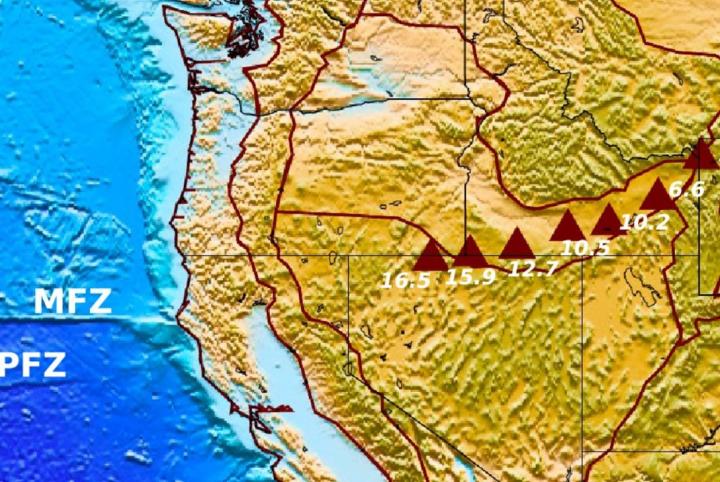Yellowstone super-volcano has a different history than previously thought

This is the location of the Yellowstone's hotspot track. The triangles indicate general locations of the Yellowstone and Snake River Plain age-progressive volcanoes with ages shown in millions of years, plotted on a topography map of the Western United States. Credit: Virginia Tech
The long-dormant Yellowstone super-volcano in the American West has a different history than previously thought, according to a new study by a Virginia Tech geoscientist.
Scientists have long thought that Yellowstone Caldera, part of the Rocky Mountains and located mostly in Wyoming, is powered by heat from the Earth's core, similar to most volcanoes such as the recently active Kilauea volcano in Hawaii. However, new research published in Nature Geoscience by Ying Zhou, an associate professor with the Virginia Tech College of Science's Department of Geosciences, shows a different past.
“In this research, there was no evidence of heat coming directly up from the Earth's core to power the surface volcano at Yellowstone,” Zhou said. “Instead, the underground images we captured suggest that Yellowstone volcanoes were produced by a gigantic ancient oceanic plate that dove under the Western United States about 30 million years ago. This ancient oceanic plate broke into pieces, resulting in perturbations of unusual rocks in the mantle which led to volcanic eruptions in the past 16 million years.”
The eruptions were very explosive, Zhou added. A theoretical seismologist, Zhou created X-ray-like images of the Earth's deep interior from USArray – part of the Earthscope project funded by the National Science Foundation – and discovered an anomalous underground structure at a depth of about 250 to 400 miles right beneath the line of volcanoes.
“This evidence was in direct contradiction to the plume model,” Zhou said.
In her study, Zhou found the new images of the Earth's deep interior showed that the oceanic Farallon plate, which used to be where the Pacific Ocean is now, wedged itself beneath the present-day Western United States. The ancient oceanic plate was broken into pieces just like the seafloor in the Pacific today. A section of the subducted oceanic plate started tearing off and sinking down to the deep earth.
The sinking section of oceanic plate slowly pushed hot materials upward to form the volcanoes that now make up Yellowstone. Further, the series of volcanoes that make up Yellowstone have been slowly moving, achingly so, ever since. “The process started at the Oregon-Idaho border about 16 million years ago and propagated northwestward, forming a line of volcanoes that are progressively younger as they stretched northwest to present-day Wyoming,” Zhou added.
The previously-held plume model was used to explain the unique Yellowstone hotspot track – the line of volcanoes in Oregon, Idaho, and Wyoming that dots part of the Midwest. “If the North American plate was moving slowly over a position-fixed plume at Yellowstone, it will displace older volcanoes towards the Oregon-Idaho border and form a line of volcanoes, but such a deep plume has not been found.” Zhou said. So, what caused the track? Zhou intends to find out.
“It has always been a problem there, and scientists have tried to come up with different ways to explain the cause of Yellowstone volcanoes, but it has been unsuccessful,” she said, adding that hotspot tracks are more popular in oceans, such as the Hawaii islands. The frequent Geyser eruptions at Yellowstone are of course not volcanic eruptions with magna, but due to super-heated water. The last Yellowstone super eruption was about 630,000 years ago, according to experts. Zhou has no predictions on when or if Yellowstone could erupt again.
The use of the X-ray-like images for this study is unique in itself. Just as humans can see objects in a room when a light is on, Zhou said seismometers can see structures deep within the earth when an earthquake occurs. The vibrations spread out and create waves when they hit rocks. The waves are detected by seismometers and used in what is known as diffraction tomography.
“This is the first time the new imaging theory has been applied to this type of seismic data, which allowed us to see anomalous structures in the Earth's mantle that would otherwise not be resolvable using traditional methods,” Zhou said.
Zhou will continue her study of Yellowstone. “The next step will be to increase the resolution of the X-ray-like images of the underground rock,” she added.
“More detailed images of the unusual rocks in the deep earth will allow us to use computer simulation to recreate the fragmentation of the gigantic oceanic plate and test different scenarios of how rock melting and magma feeding system work for the Yellowstone volcanoes.”
Media Contact
All latest news from the category: Earth Sciences
Earth Sciences (also referred to as Geosciences), which deals with basic issues surrounding our planet, plays a vital role in the area of energy and raw materials supply.
Earth Sciences comprises subjects such as geology, geography, geological informatics, paleontology, mineralogy, petrography, crystallography, geophysics, geodesy, glaciology, cartography, photogrammetry, meteorology and seismology, early-warning systems, earthquake research and polar research.
Newest articles

First-of-its-kind study uses remote sensing to monitor plastic debris in rivers and lakes
Remote sensing creates a cost-effective solution to monitoring plastic pollution. A first-of-its-kind study from researchers at the University of Minnesota Twin Cities shows how remote sensing can help monitor and…

Laser-based artificial neuron mimics nerve cell functions at lightning speed
With a processing speed a billion times faster than nature, chip-based laser neuron could help advance AI tasks such as pattern recognition and sequence prediction. Researchers have developed a laser-based…

Optimising the processing of plastic waste
Just one look in the yellow bin reveals a colourful jumble of different types of plastic. However, the purer and more uniform plastic waste is, the easier it is to…



